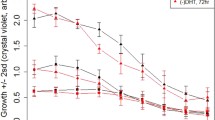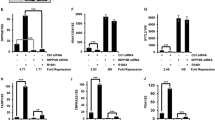Abstract
U19/EAF2 is regulated by androgens in the prostate and capable of regulating transcriptional elongation of RNA Pol II via interaction with the ELL family proteins. Inactivation of U19/EAF2 induces tumorigenesis in multiple organs; however the mechanism of U19/EAF2 tumor suppression remains unclear. To elucidate potential mechanisms of U19/EAF2 action, we performed cDNA microarray analysis and identified 164 mRNA transcripts regulated by U19/EAF2 in the mouse ventral prostate. Bioinformatics analysis indicated that U19/EAF2 knockout activates the RAS-BRAF-ERK signaling pathway, which is known to play important roles in carcinogenesis. qPCR verified increased expression of BRAF mRNA, and immunostaining and Western blot analysis demonstrated increased expression of p-ERK at the protein level suggested U19/EAF2 knockout activates this important pathway. These findings indicate that loss of EAF2 up-regulates transcription of RAS cascade genes including Grb2, PI3K, and BRAF, leading to elevated p-ERK levels, which may represent a major functional role of U19/EAF2 in the prostate. Furthermore, these observations suggest that U19/EAF2 is a key player in crosstalk between androgen receptor and the RAS-BRAF-ERK signaling pathway.




Similar content being viewed by others
References
Kozlowski JM, Ellis WJ, Grayhack JT (1991) Advanced prostatic carcinoma. Early versus late endocrine therapy. Urol Clin N Am 18(1):15–24
Montie J, Pienta K (1994) Review of the role of androgenic hormones in the epidemiology of benign prostatic hyperplasia and prostate cancer. [Review]. Urology 43(6):892–899
O’Leary MP, Roehrborn CG, Black L (2007) Dutasteride significantly improves quality of life measures in patients with enlarged prostate. Prostate Cancer Prostatic Dis
Griffiths K, Eaton C, Harper M, Peeling B, Davies P (1991) Steroid hormones and the pathogenesis of benign prostatic hyperplasia. [Review]. Eur Urol 20(Suppl 1):68–77
Zhou Z, Wong C, Sar M, Wilson E (1994) The androgen receptor: an overview. [Review]. Recent Prog Horm Res 49:249–274
Wang Z, Tufts R, Haleem R, Cai X (1997) Genes regulated by androgen in the rat ventral prostate. Proc Natl Acad Sci USA 94:12999–13004
Zhu ML, Kyprianou N (2008) Androgen receptor and growth factor signaling cross-talk in prostate cancer cells. Endocr Relat Cancer 15(4):841–849
Culig Z (2004) Androgen receptor cross-talk with cell signalling pathways. Growth Factors 22(3):179–184
Maurer G, Tarkowski B, Baccarini M (2011) Raf kinases in cancer-roles and therapeutic opportunities. Oncogene 30(32):3477–3488
Marais R, Light Y, Paterson HF, Mason CS, Marshall CJ (1997) Differential regulation of Raf-1, A-Raf, and B-Raf by oncogenic ras and tyrosine kinases. J Biol Chem 272(7):4378–4383
Niihori T, Aoki Y, Narumi Y, Neri G, Cave H, Verloes A, Okamoto N, Hennekam RC, Gillessen-Kaesbach G, Wieczorek D et al (2006) Germline KRAS and BRAF mutations in cardio-facio-cutaneous syndrome. Nat Genet 38(3):294–296
Tabernero J, Dienstmann R (2011) BRAF as a target for cancer therapy. Anti-Cancer Agent Me 11(3):285–295
Davies H, Bignell GR, Cox C, Stephens P, Edkins S, Clegg S, Teague J, Woffendin H, Garnett MJ, Bottomley W et al (2002) Mutations of the BRAF gene in human cancer. Nature 417(6892):949–954
Halilovic E, Solit DB (2008) Therapeutic strategies for inhibiting oncogenic BRAF signaling. Curr Opin Pharmacol 8(4):419–426
Pratilas CA, Xing F, Solit DB (2011) Targeting oncogenic BRAF in human cancer. Curr Top Microbiol Immunol
Ball DW, Jin N, Rosen DM, Dackiw A, Sidransky D, Xing M, Nelkin BD (2007) Selective growth inhibition in BRAF mutant thyroid cancer by the mitogen-activated protein kinase kinase 1/2 inhibitor AZD6244. J Clin Endocrinol Metab 92(12):4712–4718
Gioeli D, Mandell JW, Petroni GR, Frierson HF Jr, Weber MJ (1999) Activation of mitogen-activated protein kinase associated with prostate cancer progression. Cancer Res 59(2):279–284
Gioeli D (2005) Signal transduction in prostate cancer progression. Clin Sci (Lond) 108(4):293–308
Garraway LA, Thomas RK, Baker AC, DeBiasi RM, Winckler W, LaFramboise T, Lin WM, Wang M, Feng W, Zander T et al (2007) High-throughput oncogene mutation profiling in human cancer. Nat Genet 39(3):347–351
Barford D, Wan PTC, Garnett MJ, Roe SM, Lee S, Niculescu-Duvaz D, Good VM, Jones CM, Marshall CJ, Springer CJ et al (2004) Mechanism of activation of the RAF-ERK signaling pathway by oncogenic mutations of B-RAF. Cell 116(6):855–867
Dahut WL, Scripture C, Posadas E, Jain L, Gulley JL, Arlen PM, Wright JJ, Yu Y, Cao L, Steinberg SM et al (2008) A phase II clinical trial of sorafenib in androgen-independent prostate cancer. Clin Cancer Res 14(1):209–214
Xiao W, Zhang Q, Jiang F, Pins M, Kozlowski JM, Wang Z (2003) Suppression of prostate tumor growth by U19, a novel testosterone-regulated apoptosis inducer. Cancer Res 63(15):4698–4704
Simone F, Luo RT, Polak PE, Kaberlein JJ, Thirman MJ (2003) ELL-associated factor 2 (EAF2), a functional homolog of EAF1 with alternative ELL binding properties. Blood 101(6):2355–2362
Xiao W, Jiang F, Wang Z (2006) ELL binding regulates U19/Eaf2 intracellular localization, stability, and transactivation. Prostate 66(1):1–12
Shilatifard A, Duan DR, Haque D, Florence C, Schubach WH, Conaway JW, Conaway RC (1997) ELL2, a new member of an ELL family of RNA polymerase II elongation factors. Proc Natl Acad Sci U S A 94(8):3639–3643
Xiao W, Zhang Q, Habermacher G, Yang X, Zhang AY, Cai X, Hahn J, Liu J, Pins M, Doglio L et al (2008) U19/Eaf2 knockout causes lung adenocarcinoma, B-cell lymphoma, hepatocellular carcinoma and prostatic intraepithelial neoplasia. Oncogene 27(11):1536–1544
Cortez DA, Tonon AP, Colepicolo P, Vencio RZ (2011) Combining P values to improve classification of differential gene expression in the HTself software. Genetics and Molecular Research: GMR 10(4):3586–3595
Pascal LE, Vencio RZ, Page LS, Liebeskind ES, Shadle CP, Troisch P, Marzolf B, True LD, Hood LE, Liu AY (2009) Gene expression relationship between prostate cancer cells of Gleason 3, 4 and normal epithelial cells as revealed by cell type-specific transcriptomes. BMC Cancer 9:452
Pascal LE, Goo YA, Vencio RZ, Page LS, Chambers AA, Liebeskind ES, Takayama TK, True LD, Liu AY (2009) Gene expression down-regulation in CD90+ prostate tumor-associated stromal cells involves potential organ-specific genes. BMC Cancer 9:317
Pascal LE, Vencio RZ, Vessella RL, Ware CB, Vencio EF, Denyer G, Liu AY (2011) Lineage relationship of prostate cancer cell types based on gene expression. BMC Medical Genomics 4:46
da Huang W, Sherman BT, Lempicki RA (2009) Systematic and integrative analysis of large gene lists using DAVID bioinformatics resources. Nat Protoc 4(1):44–57
Dennis G Jr, Sherman BT, Hosack DA, Yang J, Gao W, Lane HC, Lempicki RA (2003) DAVID: Database for annotation, visualization, and integrated discovery. Genome Biol 4(5):P3
Ai J, Wang Y, Dar JA, Liu J, Liu L, Nelson JB, Wang Z (2009) HDAC6 regulates androgen receptor hypersensitivity and nuclear localization via modulating Hsp90 acetylation in castration-resistant prostate cancer. Mol Endocrinol 23(12):1963–1972
Shi Q, Pavey ES, Carter RE (2012) Bonferroni-based correction factor for multiple, correlated endpoints. Pharm Stat 11(4):300–309
Bridges LC, Tani PH, Hanson KR, Roberts CM, Judkins MB, Bowditch RD (2002) The lymphocyte metalloprotease MDC-L (ADAM 28) is a ligand for the integrin alpha4beta1. J Biol Chem 277(5):3784–3792
Crawford NP, Alsarraj J, Lukes L, Walker RC, Officewala JS, Yang HH, Lee MP, Ozato K, Hunter KW (2008) Bromodomain 4 activation predicts breast cancer survival. Proc Natl Acad Sci U S A 105(17):6380–6385
Busch C, Hanssen TA, Wagener C (2002) B OB: Down-regulation of CEACAM1 in human prostate cancer: correlation with loss of cell polarity, increased proliferation rate, and Gleason grade 3 to 4 transition. Hum Pathol 33(3):290–298
van der Rest M, Garrone R (1991) Collagen family of proteins. FASEB J: Off Publ Fed Am Soc Exp Biol 5(13):2814–2823
Hu H, Bliss JM, Wang Y, Colicelli J (2005) RIN1 is an ABL tyrosine kinase activator and a regulator of epithelial-cell adhesion and migration. Current biology: CB 15(9):815–823
Lewis TS, Shapiro PS, Ahn NG (1998) Signal transduction through MAP kinase cascades. Adv Cancer Res 74:49–139
Cobb MH, Goldsmith EJ (1995) How map kinases are regulated. J Biol Chem 270(25):14843–14846
Hynes NE, Lane HA (2005) ERBB receptors and cancer: the complexity of targeted inhibitors. Nat Rev Cancer 5(5):341–354
Allen LF, Sebolt-Leopold J, Meyer MB (2003) Cl-1040 (PD184352), a targeted signal transduction inhibitor of MEK (MAPKK). Semin Oncol 30(5):105–116
Pratilas CA, Taylor BS, Ye Q, Viale A, Sander C, Solit DB, Rosen N (2009) (V600E)BRAF is associated with disabled feedback inhibition of RAF-MEK signaling and elevated transcriptional output of the pathway. Proc Natl Acad Sci U S A 106(11):4519–4524
Bruchovsky N, Lesser B, Doorn EV, Craven S (1975) Hormonal effects on cell proliferation in rat prostate. Vitam Horm 33:61–102
Isaacs J, Furuya Y, Berges R (1994) The role of androgen in the regulation of programmed cell death/apoptosis in normal and malignant prostatic tissue. [Review]. Sem Cancer Biol 5(5):391–400
Su F, Pascal LE, Xiao W, Wang Z (2010) Tumor suppressor U19/EAF2 regulates thrombospondin-1 expression via p53. Oncogene 29(3):421–431
Colombel M, Filleur S, Fournier P, Merle C, Guglielmi J, Courtin A, Degeorges A, Serre CM, Bouvier R, Clezardin P et al (2005) Androgens repress the expression of the angiogenesis inhibitor thrombospondin-1 in normal and neoplastic prostate. Cancer Res 65(1):300–308
Fontana A, Filleur S, Guglielmi J, Frappart L, Bruno-Bossio G, Boissier S, Cabon F, Clezardin P (2005) Human breast tumors override the antiangiogenic effect of stromal thrombospondin-1 in vivo. Int J Cancer J Int Du Cancer 116(5):686–691
Kwak C, Jin RJ, Lee C, Park MS, Lee SE (2002) Thrombospondin-1, vascular endothelial growth factor expression and their relationship with p53 status in prostate cancer and benign prostatic hyperplasia. BJU Int 89(3):303–309
Pascal LE, Ai J, Rigatti LH, Lipton AK, Xiao W, Gnarra JR, Wang Z (2011) EAF2 loss enhances angiogenic effects of Von Hippel-Lindau heterozygosity on the murine liver and prostate. Angiogenesis 14(3):331–343
Xiao W, Ai J, Habermacher G, Volpert O, Yang X, Zhang AY, Hahn J, Cai X, Wang Z (2009) U19/Eaf2 binds to and stabilizes von hippel-lindau protein. Cancer Res 69(6):2599–2606
Jiang M, Ma Y, Chen C, Fu X, Yang S, Li X, Yu G, Mao Y, Xie Y, Li Y (2009) Androgen-responsive gene database: integrated knowledge on androgen-responsive genes. Mol Endocrinol 23(11):1927–1933
Long RM, Morrissey C, Walsh S, Hamilton HJ, Farrell N, O’Neill A, Fitzpatrick JM, Watson WR (2007) Alterations in the expression of inhibitors of apoptosis during differentiation of prostate epithelial cells. BJU Int 100(2):445–449
Doane AS, Danso M, Lal P, Donaton M, Zhang L, Hudis C, Gerald WL (2006) An estrogen receptor-negative breast cancer subset characterized by a hormonally regulated transcriptional program and response to androgen. Oncogene 25(28):3994–4008
Acknowledgement
This study was supported in part by National Institutes of Health Grants R37 DK51193, R01 CA 108675, and P50 CA90386 and the Tippins Foundation (LEP). This project used the UPCI Animal Facility and was supported in part by award P30CA047904. We also thank Junkui Ai and Liquan Cai for critical reading.
Disclosure Summary
The authors have nothing to disclose.
Author information
Authors and Affiliations
Corresponding author
Electronic supplementary material
Below is the link to the electronic supplementary material.
Additional File 1
Functional categories enriched in differentially expressed genes in U19/EAF2 knockout ventral prostate. (XLS 51 kb)
Rights and permissions
About this article
Cite this article
Su, F., Correa, B.R.S., Luo, J. et al. Gene Expression Profiling Reveals Regulation of ERK Phosphorylation by Androgen-Induced Tumor Suppressor U19/EAF2 in the Mouse Prostate. Cancer Microenvironment 6, 247–261 (2013). https://doi.org/10.1007/s12307-013-0132-4
Received:
Accepted:
Published:
Issue Date:
DOI: https://doi.org/10.1007/s12307-013-0132-4




